
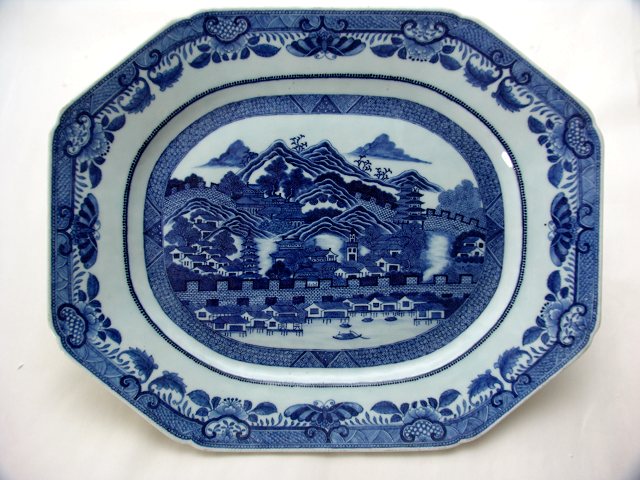
Good sized Chinese export porcelain dish with under glaze blue and white decoration with a well executed birds eye's view of the City of Guangzhou (Qianlong period 1736-95). Overall length c. 15.5 inches (39.5 cm).
Text and photo © Jan-Erik Nilsson and Cheryl Marie Cordeiro, 2006
In July 2006 the newly reconstructed Swedish East Indiaman, the Ship 'Gotheborg' finally arrived to Bocca Tigris, to later dock in the middle of the bustling City of Guanzhou, formerly known in the west as the night mythical city, Canton, of the old East India Trade. Since I had the pleasure of very much being involved in the starting of the ship building project, I had as one of my personal must do's when it finally arrived to first; be there when she entered the Pearl River to see what that looked and felt like, and then; to explore the City of Canton and see if I could navigate there by using the picture of the old city of Canton as it was depicted on this rare 18th century export porcelain dish, as a map.
For close to two thousand years this area was China's most important seaport and the starting point of the maritime 'Silk Road'. Guangzhou (formerly Canton and now a modern city of 10 million just 75 miles up the Pearl River from Hong Kong) hosted merchants from Rome and India as early as the second century A.D. and has long been intertwined with Western powers. In 1514, the Portuguese arrived and finally settled on Macao, just outside the river entrance. The Dutch followed, to settle in Jakarta in Java, then the British East India Company, who in 1711 established a trading post in Guangzhou. This was shortly followed by many European nations who through their many East India Companies established trading factories in Guangzhou and anchored their ships just nearby, down at the Huangpu village, or Whampoa, as it was called back then.
In the late 1850's, during the second Opium War, British and French forces finally established colonial rule over the city, making an island for themselves out of a sand bank in the river, called 'Sandy Face' - or Shamian. After the Qing dynasty fell in 1911, Sun Yat-sen, the father of today's China and a native son of Guangzhou, established here the headquarters of the Nationalist Party, then briefly, the nation's capital.
City, estimated population (2003): 4,653,131, capital of Guangdong province, China. Located on the Zhu (Pearl) River about 80 miles (130 km) from the sea, it is southern China's chief port. Incorporated in the Chinese empire in the 3rd century BC, it later became an important city under the Ming dynasty. The first Chinese seaport opened to foreigners, it was regularly visited by Arab and Hindu traders.
Guangzhou's resistance to the English opium trade led to war (1839-42), and it was occupied by the British and French in 1856-61. Guangzhou was one of the five Chinese treaty ports opened by the Treaty of Nanjing (signed in 1842) at the end of the First Opium War between United Kingdom and China. The other ports were Fuzhou, Xiamen, Ningbo and Shanghai.
In 1918, "Guangzhou" became the official name of the city, when an urban council was established in Guangzhou and Panyu became a county's name south of Guangzhou. In the late 19th century it was the seat of revolutionary political ideas promoted by the Nationalist Party. In 1938 Guangzhou was bombed and then occupied by Japanese troops until September 16, 1945. Its industrial growth subsequently expanded, and, with China's renewed ties to the West, it was designated as one of several economic investment areas for foreigners in 1984. One of China's largest cities, its expanding economy added to the region's growth.
It is believed that the first city in this area was built in 214 BC, and called Panyu (the locals pronounced this in Cantonese as Poon Yu) and have had a continuous occupation since that time. In 206 BC, it became the capital of Kingdom Nanyue, and the city was expanded.
In 111 BC the North Chinese Han Dynasty annexed Nanyue and Panyu became a provincial capital to remains so until today. In 226 AD, Panyu became the seat of the Guang Prefecture (Guangzhou). Therefore, Guangzhou was the name of the prefecture, not of the city. However, people had grown accustomed to calling the city Guangzhou, instead of Panyu.
The decoration of the dish is set against a background of a mountainous area which is not really there in reality. It is the White Cloud Mountain area located 7.5 km northeast of Guangzhou and an offshoot of the Dayu Ling, the main mountain range of Guangdong province. The White Cloud Mountain consists of some 30 peaks covering a large area. The highest peak, Moxing Ridge, or The Ridge that Reaches the Stars is with its 382 meters regarded as "the First Peak under the Southern Sky".
Descriptions of the beauty of the lush and tropical nature of the Guangzhou area often refer to "pearly water and white clouds". The name of the mountain area is derived from the white clouds that often fly over it. The magnificent scenery and abundance of historical relics have made this a famous scenic spot in Guangzhou since ancient times. It is today a park with natural hills and waters, ideal for sightseeing and as a summer resort, with a history of development of over 1,000 years. Locations such as 'Wind Soughing in the Pines on White Cloud Mountain', 'Pujian Spring', and 'Looking Afar in the Evening from White Cloud Mountain', the 'Returned Monk at Jingtai', the 'Splendid Mountain of Cloud', etc. are all famous scenic spots in this mountain. Renowned poets and scholars of past dynasties, such as Sushi, Yang Wanli, Wang Shizhen and others have once came here and written their experiences in poetry and prose for posterity.
This month when the Swedish ship, the reconstructed 18th century East Indiaman Gotheborg III finally arrived to Guangzhou or Canton, as it was known as to westerners in the 18th century, it feels extra relevant to point some attention to this very rare export porcelain decoration portraying the city of Canton as it looked at the time when the old East Indiamen came there to trade.
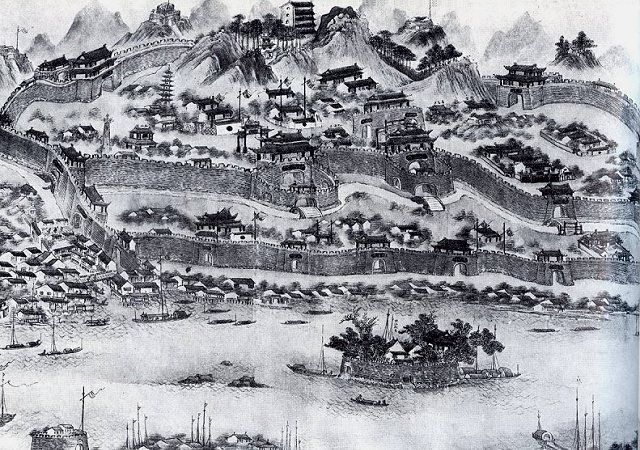
Map of Canton, in the collection of the Kina Slott castle, Stockholm. In the group of houses to the left on this picture were the trading offices, or the factories, as the merchant offices was called, that was rented by the western East India companies to be used for their businesses while in Canton. These house facades was often depicted on export paintings and porcelain with western flags outside them. These buildings are not shown individually in this paining.
Any exact source for the decoration of this dish is not known, but as a comparison and to show a similar birds eye view, I would like to point towards an album leaf in the collection of the Swedish 'Kina Slott' castle in Stockholm, dating to the 1740s. In this picture we can find a high degree of similarity and also make out some of the buildings.
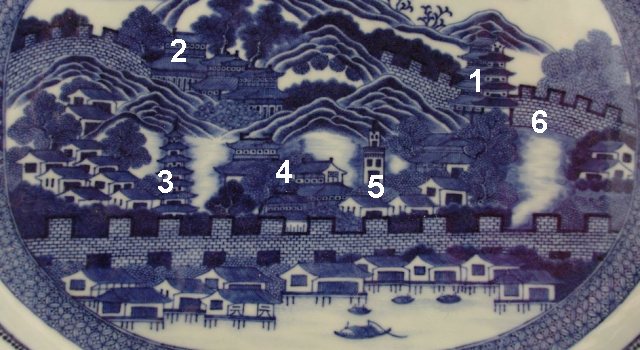
On this dish many of the landmarks can be recognized, such as The Five Storey Pagoda (1) which was a part of the city wall and are still standing today.
On this dish many of the landmarks can be recognized, such as the Five Storey Pagoda, which was a part of the city wall and are still there today. Of the six most prominent landmarks visible on the dish, I will here try to suggest which these could be.
There are many old and significant sites to choose from. Unfortunately many of those are now gone. What we can assume is that every larger building in the decoration are relevant and would carry a meaning to an 18th century visitor to Canton, while a number of houses might be there to just signify the city scape.
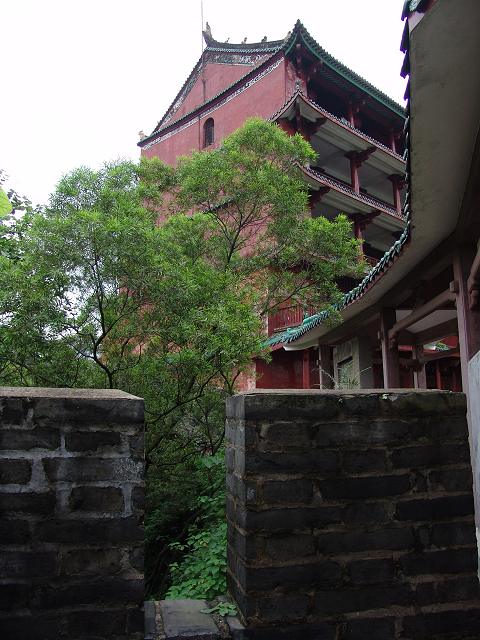
The Five Storey Pagoda as it looks today.
Top right on the dish, and at the far north end of an imaginary line that the old city of Canton was oriented after, is the Zhenhai Tower or The Five Storey Pagoda which is actually a rectangular building that looks nothing like a pagoda. It is built on top of the Yuexiu Hill and offers a splendid view of both the City of Guangzhou to the south and, the northern suburbs on the other side of the hill, which is a little bit of a surprise when you are up there. The tower is 28 meters high and was first erected in 1380 by Zhu Liangzu during the Ming Dynasty (1368-1644).
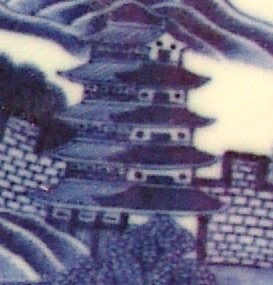
The Five Storey Pagoda as shown on the dish.
The wall being kept in good repair.
During its more than 600 year long history the tower has been destroyed and rebuilt five times. It now houses the City Museum and exhibit the history of Guangzhou, from Neolithic times until the early part of the 20th century. British and French troops occupied the tower during the Opium Wars on account of its strategic location. A number of awkward cast iron cannons that are still littering the ground around the tower are from that time.
The oldest city of Guangzhou was oriented along an imaginary north - south axis, along which many important buildings were located. At the far north end of that line, on the Yuexiu Hill, the Zhenhai Tower or the Five Storey Pagoda, was located at least as much for fengshui purposes as for defence.
To get up to it is a bit of a hassle for westerners if you want the experience and feel of getting up to it on your own, and you don't do this within a tour that would drive you right up to it and drop you off right outside. Taxis or private cars does not seem to be allowed and the climate of Guangzhou is subtopic, which translates to very warm and humid during the summer, with up to 99 percent air humidity. On pictures this look all lush and green but to actually walk here takes all you got, and the feeling easily matches slugging your way through a tropical rain forest.
It is hard to believe that temperatures here can actually drop towards freezing in the winter.
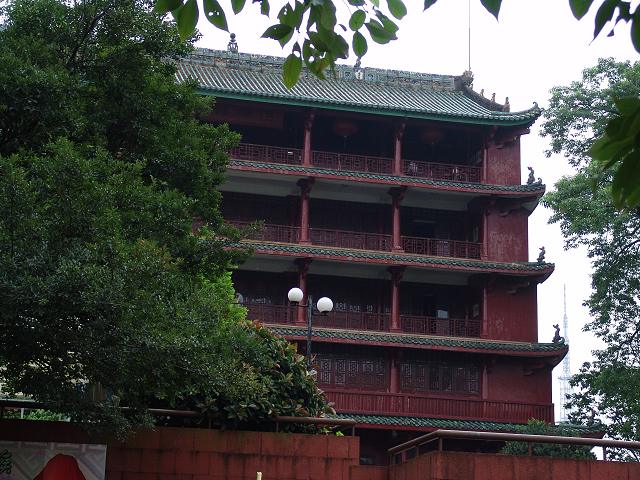
A number of old cast iron cannons of unmistakable 18th century model are said to date to the opium wars in the 1840-60s. Chinese junks and pirate ships until at least early 20th century was known to utilize this outdated armory for their business activities.
The Flowery Pagoda as in 'the decorated' pagoda

To the bottom left section of the dish, there is a pagoda with seven visible roofs. This is the so called Flowery pagoda meaning 'decorated' pagoda due to its ornamented exterior. The pagoda is located inside a temple called the Temple of the Six Banyan tress, or in Chinese, Liu Rong. The name 'Liu Rong' came from that during the Song Dynasty, Su Shi, a celebrated poet, visited what was then called the Baozhuangyan Temple, built in AD 537, and left the two characters "liu rong" (six banyan trees) in his calligraphy to the temple. After this the temple was called the "Liu Rong Temple".
The octagonal, nine-storey, wood and brick pagoda stands 57 meters high in the center of the temple, making it a fairly high one among ancient pagodas in south China. The original pagoda was a huge square wooden structure but this burnt down in the tenth century and was reconstructed in 1097 during the Song dynasty, to its present form. Although it has been rebuilt several times since then, the main body has been retained. In 1980, when the pagoda was being repaired, bricks inscribed with the names of periods of the Northern Song Dynasty were found.

In front of the Flowery (decorated) Pagoda inside the The Six Banyan Tree Temple
Photo Jan-Erik Nilsson, July 2006
For each external storey there is one hidden storey inside making the pagoda a structure of seventeen storeys. There are staircases for climbing up and down. The steeple is made of copper and iron. The steeple, including the bead on its top and the iron chains running from the top to other storeys of the pagoda, weighs five thousand kilograms. The thousand-Buddha copper mainstay on the top of the pagoda was cast in 1358 during the Yuan Dynasty (1271-1368 AD) and bears nine tiers of discs.

The Huaisheng Mosque is one of the oldest mosques in China and dates to the 7th Century during the Tang Dynasty (618-907), about when Islam was first introduced to China.

The 'smooth pagoda'
This might take a little bit of explanations but basically in the middle of Guangzhou city suddenly appears in front of your eyes a gray straight column with no decorations at all. It is a cylindrical brick structure 36.3 meters high featuring a central pillar with inside a winding staircase leading up to the top. Making your eyes follow this structure upwards you notice a top and a railed balcony that you readily recognizes as a lighthouse. Now this can not be of course. One of the reasons being this is far up on land and they don't even have this kind of lighthouses in China. The explanations lies in the early trade relations between China and the Arab world and the construction you see in front of you is actually the Huaisheng 'remember the sage' mosque, built in 627.
The Huaisheng Mosque features six important buildings of which the Light Tower minaret is one and the other the Imam Hall, the Wangyue Attic, the Covered Corridor, the Storehouse of Islamic Scripture and the Stone Stele Pavilion.
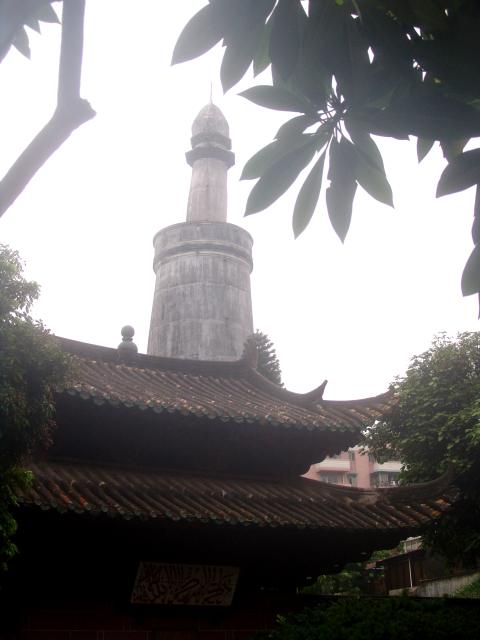
Making your eyes follow this structure upwards you notice a top and a railed balcony that you readily recognizes as a lighthouse.
The Light Tower name seems to have come about when the minaret actually got to be used to serve as a beacon for boats on the Zhujiang (Pearl River). Although the mosque presents a typical architectural style of the Tang Dynasty, the Light Tower seems to develop a new school of its own influenced by Arabic architecture. After what I could understand this staircase was now closed for the public.

the Bright Filial Piety Temple on Guangxiao Road
To the top left on the dish we find a large architectural structure. Local historians when asked were immediately able to identify this as the Bright Filial Piety Temple on Guangxiao Road. This is one of the oldest Buddhist temples in Guangzhou and and also most important religious and historical places in the area. In the temple a few verses call this the birthplace of Chinese Buddhism. The persons and relics that are kept here are also quite important in Buddhist history.
Originally this was the residence of Prince Zhao Jiande of the Nanyue Kingdom during the Western Han Dynasty (206 B.C-A.D.24). Around 200 years later, during the period of the Three Kingdoms (220-280 AD) Yufan, an aristocrat of the Yu family, was exiled to Nanhai and is known to have delivered lectures here which was then called the Yu Garden. It was also the family of Yu who after the death of Yufan who donated the buildings to become a Buddhist temple. The Sixth Ancestor Hall in the temple was built in memory of Huineng, the sixth master of the Zen Sect of Buddhism, who was also the most influential monk in the history of Chinese Buddhism.
In the temple there is also a pagoda where Huineng's hair was buried. Other ancient structures in the temple include Sakyamuni Hall, Samgharama Hall, the King of Heaven Hall, and two iron towers.
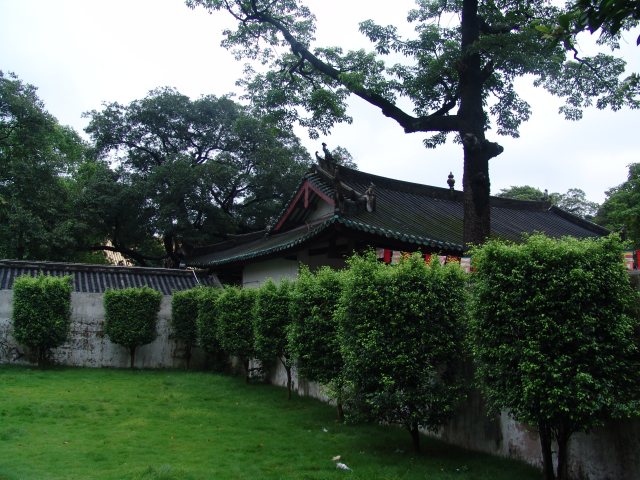
The Bright Filial Temple, Guangxiao, from the outside
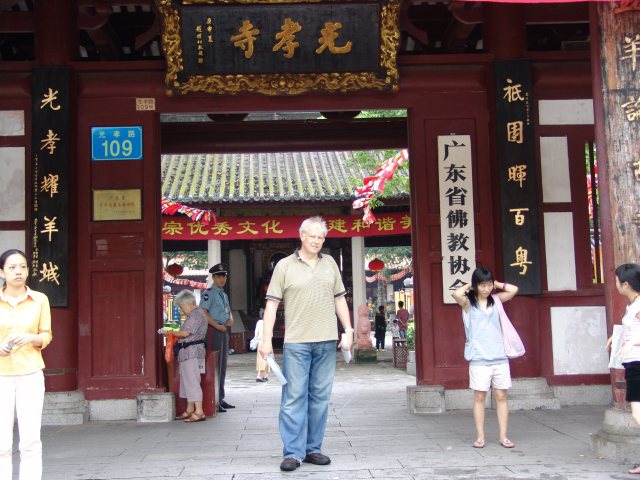
The main entrance as it looks today

On either side of the main entrance imposing brass figures guard the way

This building until further remain uncertain
This building until further remain uncertain. During the early republic days of Sun Yat-sen around 1920, when Guangzhou also briefly was the capital of China, all temples and religious buildings were nationalized. Many were torn down and the land sold to finance reforms and in practise the troops needed for the defence of the young republic. Looking at the dish, this building is located between the 'Flowery pagoda' and the 'Smooth pagoda'. If that is the actual place, there were indeed once a temple but on this site today is however only the Yin Bin Hotel, flaunting a slightly outdated Moscow style. The staff had no idea what had been on this location before the Hotel. While strolling in the lush garden this is filled of age old trees suggesting that here might once have stood something else, but until further - I don't know what.

The city wall
The old city wall was originally in two sections. The inner city wall was encircling the old town but after the river had been silting up, a second outer wall had been build to protect also the new city now next to the river. The wall was there both for defense purposes but also to protect from flooding, of feng shui purposes and to protect from bad spirits.
The only section of the city wall that still remains today is located immediately next to the Five Story Pagoda. In fact, the wall is visible next to the steep road leading up to it. In the mid 1920 a visitor wrote that the only remaining northern corner of the wall was carried away 'brick by blue brick' for other purposes and that the nearby rickety five story's tower was on the brink of falling apart.
On my visit in 2006 the wall had been repaired and from the looks of the wall much were original. Older sections was visible as in layers closer to the base and could well be several thousand years old as is in fact the city.
The old city wall of Guangzhou has otherwise been an item of pride, mentioned in every written account from any visits to this city. The wall was torn down by Sun Yat-sen during his rule of the city in the 1920s and the space thus freed was turned into wide avenues. Several more avenues totally out of proportion at that time, were drawn across the city in an attempt to modernize the city plan. Since Sun Yat-sen seems to have used his army for the construction work no compensations seems to have been left to all who lost their homes in that process. The suffering in China before and after this was and have been of such a massive scale that any details about a small thing like this appears to have been lost as of no particular significance.

The city wall still standing along the road leading up to the Five Storey Pagoda in the northern most corner of the old City of Guangzhou.
Photo by Jan-Erik Nilsson, July 2006
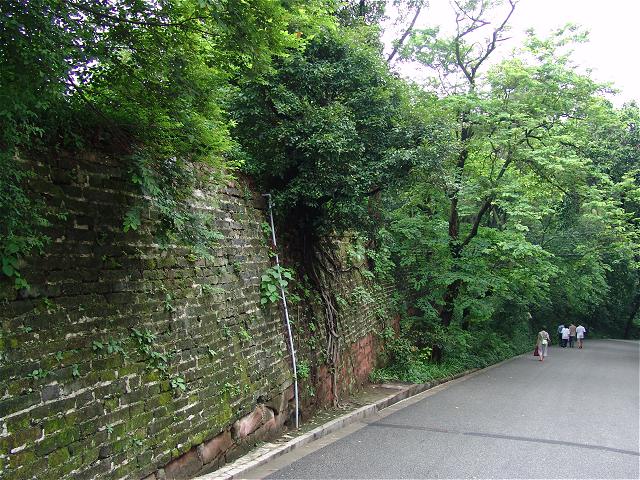
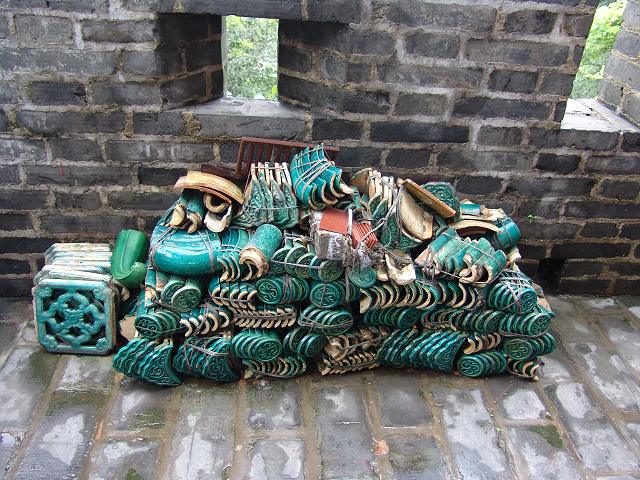
Next to the tower a cannon gate, battlements and bundles of glazed Shiwan tiles bearing witness of the on-going renovations.
Photo by Jan-Erik Nilsson, July 2006